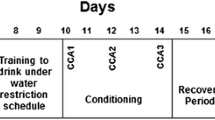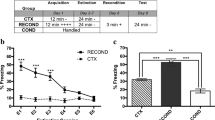Many animal species are able to use context as a conditioned signal for learning. In some cases, the initial memorization of the context and its subsequent association with an unconditioned stimulus can be separated by a long period of time – a phenomenon termed the “context preexposure effect.” This type of associative learning is based on a reminder and is significantly different from the classical version, though its properties have previously been studied only in rats. The present study addressed the formation of this type of conditioned link in mice. The conditioned signal was the context of a chamber, which the animals were allowed to explore for 5 min. After different time intervals, the mice were placed in the same chamber for 2 sec, during which they were given immediate electrocutaneous shocks (ECS). The mice formed a specific aversive memory for the preexplored context; formation of the memory did not occur if the animals received the same ECS in a context which was novel for them. This associative learning occurred in mice on application of the conditioned and unconditioned stimuli with intervals ranging from 30 min to 30 days. The resulting memory was long-term, persisting for at least 30 days. These results open up the potential for using mice of various transgenic strains for studying the cellular and molecular mechanisms of this type of associative learning.
Similar content being viewed by others
References
Amel’chenko, E. M., Zvorykina, S. V., Bezryadnov, D. V., et al., “Memory repair: a reminder restores conditioned reflex freezing impaired by a protein synthesis inhibitor in mice,” Zh. Vyssh. Nerv. Deyat., 63, No. 2, 227–234 (2013).
Bevins, R. A., McPhee, J. E., Rauhut, A. S., and Ayres, J. J., “Converging evidence for one-trial context fear conditioning with an immediate shock: importance of shock potency,” J. Exp. Psychol. Anim. Behav. Process., 23, No. 3, 312–324 (1997).
Biedenkapp, J. C. and Rudy, J. W., “Context preexposure prevents forgetting of a contextual fear memory: implication for regional changes in brain activation patterns associated with recent and remote memory tests,” Learn. Mem., 14, No. 3, 200–203 (2007).
Bourtchouladze, R., Abel, T., Berman, N., et al., “Different training procedures remit either one or two critical periods for contextual memory consolidation, each of which requires protein synthesis and PKA,” Learn. Mem., 5, No. 4–5, 365–374 (1998).
Brown, K. L., Kennard, J. A., Sherer, D. J., et al., “The context preexposure facilitation effect in mice: a dose-response analysis of pre-training scopolamine administration,” Behav. Brain Res., 225, No. 1, 290–296 (2011).
Fanselow, M. S., “Conditional and unconditional components of postshock freezing,” Pavlov J. Biol. Sci., 15, No. 4, 177–182 (1980).
Fanselow, M. S., “Factors governing one-trial contextual conditioning,” Anim. Learn. Behav., 18, No. 3, 264–270 (1990).
Fanselow, M. S., Kim, J. J., Yipp, J., and De Oca, B., “Differential effects of the N-methyl-D-aspartate antagonist DL2-amino-5-phosphonovalerate on acquisition of fear of auditory and contextual cues,” Behav. Neurosci., 108, No. 2, 235–240 (1994).
Frankland, P. W., Josselyn, S. A., Anagnostaras, S. G., et al., “Consolidation of CS and US representations in associative fear conditioning,” Hippocampus, 14, No. 5, 557–569 (2004).
Guenthner, C. J., Miyamichi, K., Yang, H. H., et al., “Permanent genetic access to transiently active neurons via TRAP: Targeted Recombination in Active Populations,” Neuron, 78, No. 5, 773–784 (2013).
Matus-Amat, P., Higgins, E. A., Barrientos, R. M., and Rudy, J. W., “The role of the dorsal hippocampus in the acquisition and retrieval of context memory representations,” J. Neurosci., 24, No. 10, 2431–2439 (2004).
Murav’eva, E. V. and Anokhin, K. V., “Involvement of protein synthesis in memory reconsolidation at different times after training to conditioned reflex freezing in mice,” Zh. Vyssh. Nerv. Deyat., 56, No. 2, 274–282 (2006).
Nakayama, D., Baraki, Z., Onoue, K., et al., “Frontal association cortex is engaged in stimulus integration during associative learning,” Curr. Biol., 25, 117–123 (2015).
Reijmers, L. G., Perkins, B. L., Matsuo, N., and Mayford, M., “Localization of a stable neural correlate of associative memory,” Science, 317, No. 5842, 1230–1233 (2007).
Rudy, J. W. and Morledge, P., “Ontogeny of contextual fear conditioning in rats: implications for consolidation, infantile amnesia, and hippocampal system function,” Behav. Neurosci., 108, No. 2, 227–234 (1994).
Rudy, J. W. and O’Reilly, R. C., “Conjunctive representations, the hippocampus, and contextual fear conditioning,” Cogn. Affect. Behav. Neurosci., 1, No. 1, 66–82 (2001).
Rudy, J. W. and O’Reilly, R. C., “Contextual fear conditioning, conjunctive representations, pattern completion, and the hippocampus,” Behav. Neurosci., 113, No. 5, 867–880 (1999).
Rudy, J. W. and Wright-Hardesty, K., “The temporal dynamics of retention of a context memory: something is missing,” Learn. Mem., 12, 172–177 (2005).
Rudy, J. W., “Context representations, context functions, and the parahippocampal-hippocampal system,” Learn. Mem., 16, No. 10, 573–585 (2009).
Rudy, J. W., Huff, N. C., and Matus-Amat, P., “Understanding contextual fear conditioning: insights from a two-process model,” Neurosci. Biobehav. Rev., 28, 675–685 (2004).
Westbrook, R. F., Good, A. J., and Kiernan, M. J., “Effects of the interval between exposure to a novel environment and the occurrence of shock on the freezing responses of rats,” Q. J. Exp. Psychol. B., 47, No. 4, 427–446 (1994).
Wheeler, A. L., Teixeira, C. M., Wang, A. H., et al., “Identification of a functional connectome for long-term fear memory in mice,” PLoS Comput. Biol., 9, No. 1, el002853 (2013).
Zvorykina, S. V. and Anokhin, K. V., “Studies of the topography of c-fos-expressing neurons in the mouse neocortex on training to conditioned refl ex freezing,” Zh. Vyssh. Nerv. Deyat., 53, No. 4, 518–522 (2003).
Author information
Authors and Affiliations
Corresponding author
Additional information
Translated from Zhurnal Vysshei Nervnoi Deyatel’nosti imeni I. P. Pavlova, Vol. 66, No. 3, pp. 352–360, May–June, 2016.
Rights and permissions
About this article
Cite this article
Vorob’eva, N.S., Ivashkina, O.I., Toropova, K.A. et al. Long-Term Contextual Memory in Mice: Persistence and Associability with Reinforcement. Neurosci Behav Physi 47, 780–786 (2017). https://doi.org/10.1007/s11055-017-0467-2
Received:
Accepted:
Published:
Issue Date:
DOI: https://doi.org/10.1007/s11055-017-0467-2




